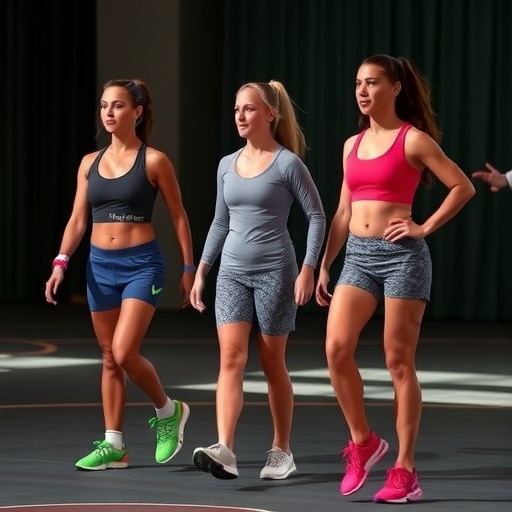A groundbreaking global analysis spearheaded by researchers from Karolinska Institutet and Shanghai University of Sport has illuminated the profound impact of societal development and gender equality on the cardiorespiratory fitness of young adults worldwide. Published in the prestigious Journal of Sport and Health Science, this meticulous investigation synthesizes data from an astounding 95 studies encompassing over 119,000 participants across 24 diverse nations, unveiling patterns that link physical capacity intimately with socioeconomic and gender-related factors.
At the core of this comprehensive study lies the pivotal measurement of cardiorespiratory fitness (CRF), quantitatively expressed through VO2peak—the maximal oxygen uptake during intense physical exertion. VO2peak serves as a robust biomarker not only for athletic prowess but also for overall cardiovascular health and longevity. The analysis reveals that CRF is far from uniform across the globe; instead, it mirrors the complex interplay of a country’s developmental status and its commitment to gender equity.
Delving into the intersection of social indices, the researchers correlated VO2peak with the Human Development Index (HDI) and the Gender Inequality Index (GII). The HDI encapsulates a composite measure of life expectancy, educational attainment, and income per capita—parameters indicative of a nation’s holistic progress. Meanwhile, the GII gauges disparities between genders in health, education, and labor market participation, reflecting societal commitment to gender parity. The study’s nuanced insights reveal a conspicuous trend: individuals residing in countries with elevated HDI scores consistently exhibit superior cardiorespiratory fitness, with this association being markedly prominent among young women.
In countries classified under medium HDI, young women demonstrated a mean VO2peak of 31.2 mL/kg/min, surpassing their counterparts in low HDI territories, who averaged 28.5 mL/kg/min. Intriguingly, elevating HDI beyond the medium threshold to high levels yielded only marginal gains, suggesting a potential saturation effect or the influence of other extrinsic factors beyond socioeconomic metrics alone. This observation accentuates the multifaceted influences on physical fitness, running deeper than standard economic progress measures.
Gender equality emerges as a decisive protagonist in this fitness narrative. The study elucidates a compelling correlation between reduced gender disparities and elevated cardiorespiratory capacity across both sexes, yet the impact remains especially profound in women. In societies where gender inequality is minimized, young women’s average VO2peak exceeds that of their peers in less equitable nations by an impressive 6.5 mL/kg/min. Such a substantial differential underscores the vital role that equitable social structures play in enabling and encouraging physical activity and health.
The research team, led by Nicolas Pillon from Karolinska Institutet’s Department of Physiology and Pharmacology, emphasizes the overarching significance of these societal determinants. “Our findings suggest that the frameworks within which individuals live profoundly shape their opportunities and motivation for physical exercise, which in turn governs cardiorespiratory fitness levels,” Pillon remarks. This paradigm challenges simplistic notions that physical fitness is merely a matter of personal choice or genetics, advocating for a broader lens that includes social and economic contexts.
Barbara Ainsworth, head of the study and a distinguished researcher at Shanghai University of Sport, echoes this sentiment, highlighting the urgent necessity for targeted policies and interventions. She stresses that mitigating socio-gender barriers extends beyond improving individual health parameters; it is a collective imperative to enhance public health landscapes and foster inclusive societies. However, Ainsworth also cautions that the current data pool is disproportionately skewed towards nations with medium to high HDI, urging more investigative efforts within low HDI countries and ethnically diverse, socioeconomically varied communities.
This research not only substantiates the symbiotic relationship between human development, gender equality, and physical fitness but also impels policy-makers, health professionals, and community leaders to formulate comprehensive strategies. Such approaches would ideally dismantle entrenched inequities obstructing physical activity access and participation, especially among young women, thereby catalyzing healthier populations globally.
Crucially, the study was generously supported by the Novo Nordisk Foundation and Diabetes Wellness Network Sverige, illustrating a collaborative paradigm between academic inquiry and philanthropic engagement focused on health advancement. Notably, the investigators reported no conflicts of interest, underscoring the integrity and impartiality of the findings presented.
From a technical perspective, VO2peak measurements adhere to standardized protocols involving graded exercise testing with respiratory gas analysis, ensuring cross-study comparability. This methodological rigor accentuates the reliability of the synthesized data and the validity of cross-national fitness comparisons.
The implications of this global systematic review ripple through multiple domains—highlighting how macro-level social determinants insidiously sculpt micro-level physiological outcomes. As nations grapple with rising non-communicable diseases partly attributable to sedentary lifestyles, understanding such associations is pivotal for crafting efficacious health promotion frameworks.
In conclusion, this landmark study compellingly argues that cardiorespiratory fitness is as much a social construct as a biological phenomenon, shaped by the intricate fabric of human development and gender equality. Its revelations beckon a future where enhancing societal structures becomes as crucial as encouraging individual exercise, embedding health equity at the nexus of public policy and personal well-being.
Subject of Research: People
Article Title: Human development and gender inequality are associated with cardiorespiratory fitness: A global systematic review of V̇O2peak
News Publication Date: 22-Oct-2025
Web References: http://dx.doi.org/10.1016/j.jshs.2025.101098
Image Credits: Karolinska Institutet
Keywords: Gender, Physical exercise, Public health, Socioeconomics




